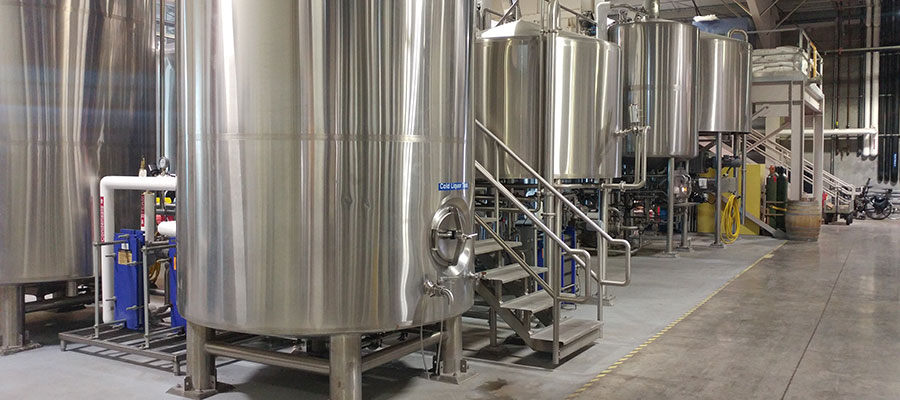The Use of Flushing Nozzles to Clean a Lauter Tun

Every industry requires a consistent, proper process for cleaning equipment. In the brewing industry, sanitation is extraordinary crucial. Contaminated or infected batches can cause serious illness if distributed to consumers. From a management perspective, failing to comply to proper hygiene standards can negatively affect your brand and business, ultimately resulting in profit loss. Equipment cleaning must be a component of any brewing company’s standard operating procedures.
However, while the brewing industry probably agrees that equipment cleaning is important, the sanitation process is not always a simple task. On one hand, various pieces of equipment must be cleaned, often with differing methods. Storage tanks, brew kettles, bottling equipment, and many more pieces play important roles in a start-to-finish beer brewing process. While all equipment must be sanitized, not all equipment is built with cleaning and sanitation in mind.
In the brewing industry, the Lauter Tun is one particularly challenging piece of equipment to clean. At Lechler, we addressed the challenge with a helpful, custom engineered spray solution. In the content below, we explore the role of the Lauter Tun in the brewery process, cleaning challenges associated with this piece of equipment, and Lechler’s custom solution.
The Importance of the Lauter Tun
As brewing experts know, the Lauter Tun performs an incredibly important task in the brewery process: filtration. The wort is sifted through the grain bed like a sieve, collecting in the space below. Once collected, the brewing process continues.
The method is highly innovative, and the Lauter Tun is ingenious – but it proves difficult to clean.
What Cleaning Challenges are Associated with the Lauter Tun?
Due to its design, though an advanced and crucial part of the brewing process, manual cleaning is often required to completely sanitize the Lauter Tun. Manual cleaning is both time-consuming and tedious.
What makes the Lauter’s design so challenging? Primarily, the Lauter Tun’s slotted false bottom. Grains must be removed from the Lauter’s filtration screen. Cleaning methods often include rinsing the grain from above, filling and soaking the tank, or installing nozzle jets underneath the false bottom – each has failed to efficiently and accurately sanitize the Lauter Tun.
Flushing Nozzles: The Cleaning Solution
When our team at Lechler became aware of this problem, we worked closely with an equipment manufacturer to develop an efficient, reliable, and precise cleaning solution for the Lauter Tun screen. Geared for spray coverage and optimal cleaning, the engineers designed an exclusive flushing nozzle assembly.
The assembly consists of one full cone spray and six, flat fan sprays. Each perform a unique task. The full cone nozzle sprays upward, removing grains from the screen; simultaneously, the flat fan spray nozzles spray outward, along the edges and corners. The spray moves the debris toward the bottom drain, so no particles or residue remains inside the Lauter Tun.
Brewing companies benefit greatly from eliminating the tedious process of manual cleaning and implementing flushing nozzles. Cleaning cycle times are reduced, less water is consumed, and the brewing process is accelerated – without compromising quality. The unique flushing nozzle complement the four tank cleaning principles: chemistry, time, temperature, and mechanical action. When addressed correctly, brewing companies – and a wide variety of industries – will save money, resources, and improve their bottom line.
Chemistry: The proper cleaning agent should be employed for your specific application, brewing or otherwise. Alkaline detergents, acidic cleaners, and disinfectants categorize tank cleaning chemicals. Once the proper chemical is chosen, it must be correctly handled and distributed – too much or too little could disrupt the cleaning process.
Time: Proper timing can be challenging to determine. The time is takes to clean depends on situation-specific factors, such as tank type, size, and soil concentration.
Temperature: Temperature and chemistry must exist in correct conjunction to avoid chemical reactions. Fortunately, breweries do not have to try and fail to discern proper temperatures. Chemical providers offer optimal temperatures, and these should be followed.
Mechanical Action: Mechanical action, of course, is the means by which chemicals, time, and temperature are distributed to clean and sanitize equipment. The right nozzle for a specific application, such as this, cuts extraneous costs – reducing solvent consumption and shortening the cleaning cycle. In the case of the Lauter Tun, Lechler’s custom engineered flushing nozzle system is an ideal mechanical piece for cleaning.
Lechler: Engineering Your Spray Solution
At Lechler, we are dedicated to listening to our customers, identifying serious problems, and collaborating with our equipment manufacturers to design reliable, custom solutions. Ultimately, these solutions solve industry issues and benefit companies for decades.
Our entire inventory of precision products extends to all markets, from food and beverage to cement. Our tank and equipment cleaning nozzles are economical, reliable, and time-tested. Lechler offers static spray balls (such as the flushing nozzles), free spinning heads, controlled rotation, and gear-controlled nozzles, each with a unique purpose and function. Alongside tank cleaning nozzles, we provide air nozzles, flat fan nozzles, pneumatic atomizing nozzles, and a plethora more. Our goal: to support our customers with precise, engineered solutions designed to meet individual requirements.
To learn more, contact us today at (800) 777-2926 or via our online contact form. We look forward to working alongside you!